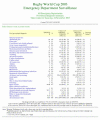An automated, broad-based, near real-time public health surveillance system using presentations to hospital Emergency Departments in New South Wales, Australia
- PMID: 16372902
- PMCID: PMC1361771
- DOI: 10.1186/1471-2458-5-141
An automated, broad-based, near real-time public health surveillance system using presentations to hospital Emergency Departments in New South Wales, Australia
Abstract
Background: In a climate of concern over bioterrorism threats and emergent diseases, public health authorities are trialling more timely surveillance systems. The 2003 Rugby World Cup (RWC) provided an opportunity to test the viability of a near real-time syndromic surveillance system in metropolitan Sydney, Australia. We describe the development and early results of this largely automated system that used data routinely collected in Emergency Departments (EDs).
Methods: Twelve of 49 EDs in the Sydney metropolitan area automatically transmitted surveillance data from their existing information systems to a central database in near real-time. Information captured for each ED visit included patient demographic details, presenting problem and nursing assessment entered as free-text at triage time, physician-assigned provisional diagnosis codes, and status at departure from the ED. Both diagnoses from the EDs and triage text were used to assign syndrome categories. The text information was automatically classified into one or more of 26 syndrome categories using automated "naïve Bayes" text categorisation techniques. Automated processes were used to analyse both diagnosis and free text-based syndrome data and to produce web-based statistical summaries for daily review. An adjusted cumulative sum (cusum) was used to assess the statistical significance of trends.
Results: During the RWC the system did not identify any major public health threats associated with the tournament, mass gatherings or the influx of visitors. This was consistent with evidence from other sources, although two known outbreaks were already in progress before the tournament. Limited baseline in early monitoring prevented the system from automatically identifying these ongoing outbreaks. Data capture was invisible to clinical staff in EDs and did not add to their workload.
Conclusion: We have demonstrated the feasibility and potential utility of syndromic surveillance using routinely collected data from ED information systems. Key features of our system are its nil impact on clinical staff, and its use of statistical methods to assign syndrome categories based on clinical free text information. The system is ongoing, and has expanded to cover 30 EDs. Results of formal evaluations of both the technical efficiency and the public health impacts of the system will be described subsequently.
Figures



References
-
- United States General Accounting Office Bioterrorism: Public health response to anthrax incidents of 2001 GAO-04-152 Washington. 2003.
-
- Campbell A. The SARS Commission Interim Report: SARS and public health in Ontario. Toronto: Ontario Ministry of Health and Long-Term Care; 2004. - PubMed
-
- Heffernan R, Mostashari F, Das D, Karpati A, Kulldorff M, Weiss D. Syndromic Surveillance in Public Health Practice, New York City. Emerg Infect Dis. 2004;10:258–264. - PubMed
MeSH terms
LinkOut - more resources
Full Text Sources
Medical

